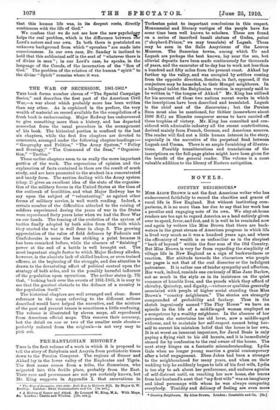nib, WAR OF SECESSION, 1861-1862.*
Tars book forms number eleven of "The Special Campaign Series," and describes the first part of the American Civil War,—a war about which probably more has been written than any other. As is explained in the preface, the very wealth of material on record available for the compilation of a fresh book is embarrassing. Major Redway has endeavoured to give something more than a history, and has departed somewhat from the usual procedure in the arrangement of his book. The historical portion is confined to the last six chapters, while the first five chapters are devoted to comments, arranged under the following chapter-headings :— " Geography and Politics," "The Army System," " Policy and Strategy," "The Command of the Seas," " Organisa- tion," " Tactics."
These earlier chapters seem to us really the more important portion of the work. The expressions of opinion and the explanation of facts contained in them are the result of much study, and arc here presented to the student in a concentrated and handy form. The section dealing with the Army system (chap. 2) gives an excellent idea of the state of the organisa- tion of the military forces in the United States at the time of the outbreak of hostilities, and what Major Redway has to say upon the subject of " volunteering," as against other forms of military service, is well worth reading. Indeed, a certain number of the difficulties attached to the raising of soldiers experienced during the years of war in the States were reproduced forty years later when we had the Boer War on our bands. The tracing of the evolution of the system of tactics finally adopted by both sides from that with which they started the war is well done in chap. 3. The growing appreciation of the value of field defences by Federals and Confederates is none the less striking a point because it has been remarked before, while the absence of " finishing " power at the end of a battle is well brought out. The most important single factor to which Major Redway alludes, however, is the absolute lack of skilled leaders, or even trained officers, at the beginning of the struggle, and due attention is drawn to the devastating effect of political control upon the strategy of both sides, and to the possibly harmful influence of the population upon operations. The author states (p. 73) that, " looking back over the events of 1861-1865, it is easy to see that the greatest obstacle to the defence of a country is the population itself."
The historical chapters are well arranged and clear. Some reference to the maps referring to the different actions described would have helped the narrative, and the mixture of the past and present tenses is sometimes a little confusing. The volume is illustrated by eleven maps, all reproduced from American official maps. This ensures their accuracy, but the detail on one or two of the smaller scale sheets— probably reduced from the originals—is not very easy to pick out.






















































 Previous page
Previous page